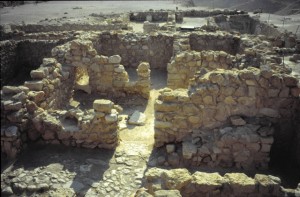Eruv and Sectarianism in Ancient Judaism: Introduction
The purpose of the presentation that follows is to argue that the Qumran sectarians, usually identified as the Essenes described by Josephus and other Greek-writing authors, prohibited carrying from domain to domain on the Sabbath, basing themselves on certain biblical passages, and that these ancient Jewish sectarians did not have an institution such as the eruv to mitigate the difficulties caused by this prohibition. Further, we will argue that the combination of this prohibition with the absence of an institution to ease the difficulties that it presents characterizes the exegetical trend of the priestly, Zadokite-Sadducee form of Jewish law, as opposed to that of the Pharisaic-rabbinic trend that developed the laws of the eruv. In making this argument, we do not intend to deny the wider ramifications of the institution of the eruv in terms of the nature of the Jewish community and its patterns of residence. Rather, our main argument is intended to show that the eruv is a Pharisaic-rabbinic device in its origins and function. While much of the research to be discussed here was already put forward in my 1975 volume, The Halakhah at Qumran, more recently published texts have confirmed a variety of readings and indicated that the prohibition on carrying was widely documented in Dead Sea Scrolls manuscripts. More recent studies, some published by this author, have indicated that there are essentially two trends in Second Temple Jewish law, and the presence of the sectarian view in the book of Jubilees and its preservation among the Samaritans, Karaites and Falashas is further confirmation that this is the approach of the Zadokite-Sadducee legal system.
Before entering into the main body of our study, it is necessary to indicate that the eruv we are discussing here is the eruv hatzerot, the mingling of courtyards, that is, residence areas, intended to permit carrying from one private domain to the next or into what may appear to be public domains until the eruv is instituted. Technically, the rabbinic eruv is being used to permit carrying in areas that after enclosure, are no longer public domains or rather constitute the intermediate domain, termed by the rabbis karmelit. In Talmudic law there are two other eruvin that will not be discussed in this presentation. One is the eruv tavshilin which allows cooking on a festival for a Sabbath that follows. Another is the eruv tehumin, “the mingling of boundaries,” the eruv that allows one to carry more than 2000 cubits beyond the limits of a settled area. While we will not be discussing this eruv either, it is worth noting that evidence in the Dead Sea Scrolls points to rejection of this rabbinic innovation as well.
Stay tuned for the continuation of this series.


Dear Sir
Can you please date the 2nd Book of Maccabees the Essenes were called school of Prophets .
Can you please date Onias III in relating to Dead Sea Scrolls?
The priestly groups at this time were Zadokites – Melchizedek Priesthoods not the Sadducees .
Can you please date from 223 – 171 BCE?
from
John Stuart
as always, Larry, fine work! Looking forward to the rest.
Carrying from a Reshut Harabim (Public Domain) to a Reshut Hayachid (Private Domain) And Vice versa was certainly prohibited by the Pharisaic Rabbis as well as the Dead sea sect. As you state, the institution of eruv was a rabbinical inovation to deal with a karmelit only. the question is, did the dead sea sect have a concept of karmelit or not. it is very possible that the absence of Eruv for the dead sea sectarians hinged on the concept of karmelit. perhaps they did not recognize a karmelit as a legal entity, believing that there were only two domains, as it would seem from the bible, and thus, an eruv was a non-starter.
It may seem a bit academic but there is an important difference.
i think the rabbis came from a perspective of not being allowed to carry in a reshut harabim. if a karmelit is not a real reshut harabim, then there is no biblical prohibition to carry to/from a reshut hayachid to the karmelit and the rabbis thus felt comfortable inventing the eruv.
the sectarians, however, may have come from the perspective of only being allowed to carry in a reshut hayachid. the karmelit was not a reshut hayachid and thus fell into the reshut harabim category and carrying therein was prohibited.
Since the Essenes were segregated from the Temple and its practices, it seems likely that any attempt to circumvent the Law as is implied by the eruv would not have been allowable.